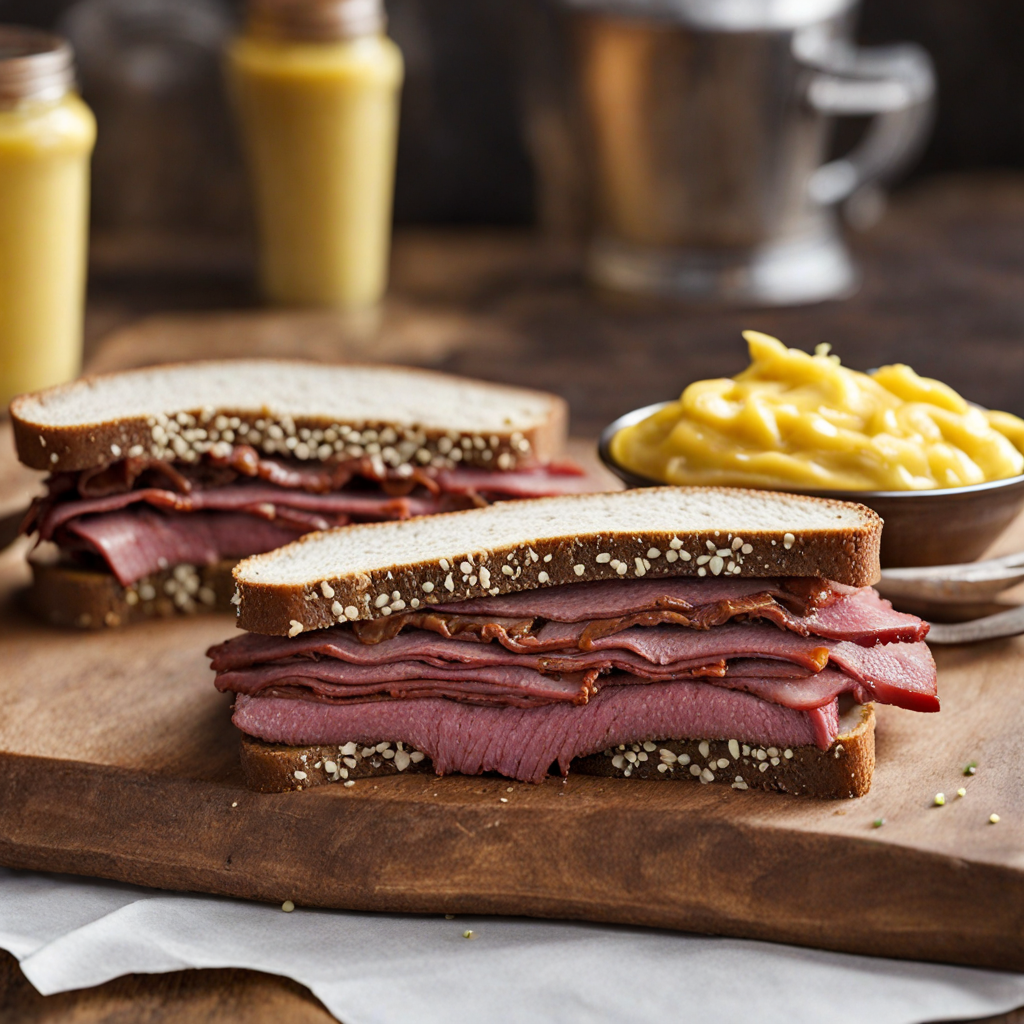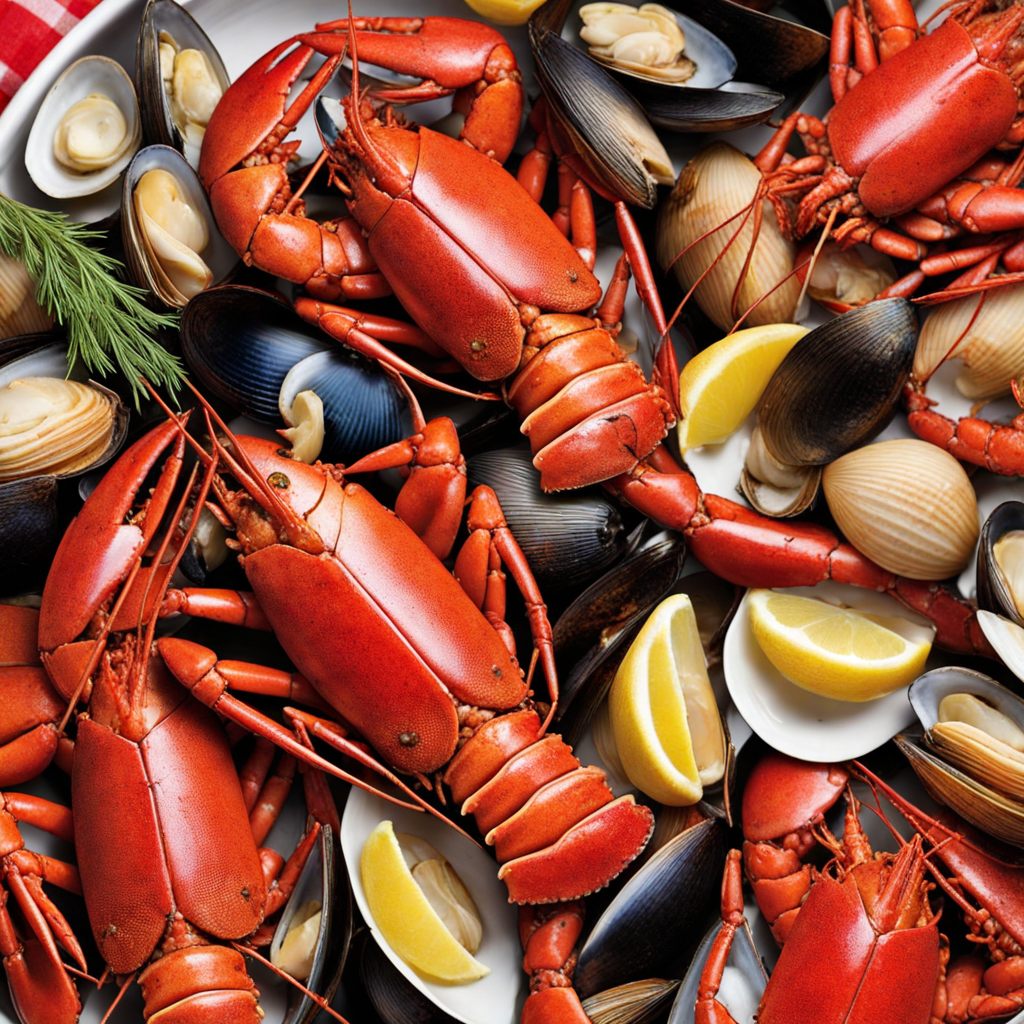Pastrami on Rye
Pastrami on Rye is a quintessential American sandwich that embodies the rich tapestry of flavors found in New York deli culture. The star of this dish is the pastrami, a succulent cut of beef brisket that is cured, seasoned with a blend of spices, and then smoked to perfection. The result is a tender, smoky, and slightly spicy meat that melts in your mouth, offering a delightful contrast to the hearty, slightly tangy rye bread that envelops it. This bread, often marbled with seeds, adds a nutty flavor and a satisfying chewiness that enhances the overall experience of the sandwich. The sandwich is traditionally served with a slathering of yellow mustard, which not only adds a sharp kick but also complements the richness of the pastrami. Some purists might argue that the sandwich is best enjoyed simply with mustard, while others might indulge in additional toppings such as pickles or coleslaw. The combination of textures and flavors creates a delightful harmony, where the spicy, smoky meat meets the tangy mustard and the crispness of the pickles, resulting in a symphony of taste that is both bold and comforting. Pastrami on Rye is not just a meal; it's a cultural experience. Often enjoyed as a hearty lunch or a late-night snack, this sandwich has become an iconic representation of Jewish-American cuisine. Whether you're biting into it at a buzzing deli surrounded by the chatter of fellow patrons or savoring it in the comfort of your own home, each bite transports you to the bustling streets of New York City, making Pastrami on Rye a must-try for anyone looking to explore authentic American flavors.
How It Became This Dish
Pastrami on rye is more than just a sandwich; it embodies a rich tapestry of cultural history, migration, and culinary evolution in the United States. This beloved deli staple, known for its savory, spiced meat nestled between two slices of rye bread, is a delicious symbol of the Jewish-American experience and broader American food culture. Origins To understand the origins of pastrami on rye, we must first look at the roots of pastrami itself. The story begins in Eastern Europe, where preserving meat was a necessity due to limited refrigeration. The word “pastrama” is derived from the Romanian term “a pastra,” which means “to preserve.” In Romania, beef was typically seasoned with a mix of spices, garlic, and salt and then smoked and air-dried, creating a savory and aromatic product that was both flavorful and preserved. Jewish immigrants brought this culinary tradition to the United States in the late 19th and early 20th centuries. As they settled in New York City and other urban areas, the need for affordable, portable food options led to the evolution of pastrami. The pastrami we know today, particularly as a sandwich, evolved from the original Eastern European preparation, with the addition of American ingredients and methods. Rye bread, a staple in Jewish delis, has its own history. Rye grain was a common crop in Eastern Europe, and rye bread was a dietary mainstay for many Jewish families. The pairing of pastrami with rye bread was a natural choice, creating a hearty meal that reflected the immigrant experience. Cultural Significance The rise of pastrami on rye coincided with the growth of Jewish delis in the United States, particularly in New York City. Delis became community hubs for Jewish immigrants, offering a sense of familiarity and comfort in a new land. Places like Katz’s Delicatessen, established in 1888, became iconic centers of social life, where families gathered to share meals, celebrate milestones, and maintain cultural traditions. Pastrami on rye became emblematic of Jewish-American identity. It represents not only the fusion of Old World flavors with New World sensibilities but also the resilience and adaptability of immigrant communities. The sandwich is a symbol of sustenance, survival, and the American dream, encapsulating the journey of countless families from Europe to America. As Jewish communities flourished, so did the popularity of pastrami on rye. The sandwich gained traction beyond the Jewish community, becoming a staple of American cuisine. It was featured in movies, literature, and television, solidifying its status as an iconic American dish. The sandwich even made its way into the lexicon of the American culinary landscape, often associated with New York deli culture. Development Over Time Throughout the 20th century, pastrami on rye underwent various transformations and adaptations. The post-World War II era saw a boom in delicatessens across the United States, fueled by a growing appreciation for diverse culinary traditions. Pastrami on rye became a favorite for lunch-goers in cities, often served with a side of pickles and mustard, further enhancing its flavor profile. The cultural significance of pastrami on rye expanded in the 1960s and 1970s, as delis began to cater to a more diverse clientele. The sandwich became increasingly popular in mainstream American culture, appearing in diners and casual eateries across the nation. This period marked a shift where pastrami on rye was no longer just a Jewish delicacy but a beloved American sandwich enjoyed by people from all walks of life. In the late 20th century, however, the traditional deli culture began to face challenges. The rise of fast food and changing dietary habits led to a decline in the number of classic Jewish delis. Many iconic establishments struggled to survive, and pastrami on rye began to lose its prominence in the rapidly changing American food landscape. However, the sandwich maintained a loyal following, prompting a resurgence in interest in artisanal and traditional food practices. Revival and Contemporary Trends In the early 21st century, there has been a renewed appreciation for traditional deli fare, including pastrami on rye. This revival coincided with a broader movement toward slow food, local sourcing, and a desire for authentic culinary experiences. New generation chefs and food enthusiasts began to explore the history of pastrami, experimenting with different preparation methods and flavor combinations while honoring its roots. Modern interpretations of pastrami on rye have emerged, allowing for creativity while still respecting tradition. Some chefs have experimented with different types of meat, such as turkey or lamb, while others have introduced unique toppings or sauces. Vegan and vegetarian versions have also appeared, catering to changing dietary preferences and reflecting a growing awareness of health and sustainability. Despite these adaptations, the classic pastrami on rye remains a cherished dish. It is often served at Jewish delis and is celebrated in food festivals, culinary events, and even pop culture references. The sandwich continues to evoke nostalgia and a sense of community, reminding us of the connections between food, culture, and identity. Conclusion Pastrami on rye is a culinary icon that tells a powerful story of immigration, adaptation, and cultural significance. It embodies the journey of Jewish immigrants who brought their food traditions to America and transformed them into something uniquely American. The sandwich not only satisfies hunger but also serves as a reminder of the rich history and the vibrant communities that continue to thrive in the United States. As we enjoy pastrami on rye today, whether at a classic deli or in a modern twist, we partake in a shared culinary legacy that transcends generations. This simple sandwich is a celebration of flavor, history, and the enduring spirit of a community that has contributed so much to the food landscape of America.
You may like
Discover local flavors from United States







